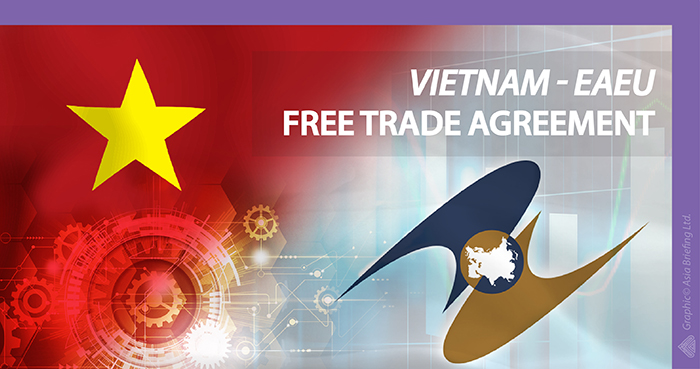
Feedback
Did you find what you were looking for?
Can we ask you a few more questions to help improve the VNTR?
 Free Trade Agreement between Vietnam and Eurasian Economic Union (EAEU - including Russia, Armenia, Belarus, Kazakhstan and Kyrgyzstan) was started negotiation by both Parties in March 2013. After 2 years of negotiations with 8 official sessions, was officially signed on May 29, 2015 in Burabay, Kazakhstan.
Free Trade Agreement between Vietnam and Eurasian Economic Union (EAEU - including Russia, Armenia, Belarus, Kazakhstan and Kyrgyzstan) was started negotiation by both Parties in March 2013. After 2 years of negotiations with 8 official sessions, was officially signed on May 29, 2015 in Burabay, Kazakhstan.
The Ministry of Foreign Affairs of Vietnam has issued a written notice that the two sides have completed the ratification procedures and the FTA between Vietnam and the Eurasian Economic Union officially took effect from October 5, 2016.
After taking effect, the two sides will establish a Joint Committee, a Committee on Trade in Goods, and a Sub-Committee on Rules of Origin to coordinate the effective implementation and at the same time supervise the implementation of the agreement.
EAEU's Commitment
The EAEU's commitment on opening the goods market (through tariff elimination) for Vietnam can be divided into the following groups:
Vietnam's commitment
Vietnam's commitment on opening the goods market to the EAEU is divided into four groups:
In order to enjoy preferential tariff under this Agreement, a good must meet the Agreement's rules of origin.
In particular, a good will be eligible to be originating in a Party (Vietnam or the EAEU) if:
In general, the Product-specific rules of origin in the Vietnam - EAEU FTA are quite simple, usually goods only need to have a value-added content – VAC ≥ 40% (some require VAC ≥ 50-60%) or there is the undergone a change in tariff classification at the level of 2, 4, and 6 digit levels to enjoy tariff preferences.
* Remark: VAC is calculated according to the formula: (FOB value – Value of non-originating materials)/ FOB value x 100%.
In addition, the Agreement has a provision on De Minimis that allows goods that do not meet the change in tariff classification but still enjoy preferential tariffs if there is a weight of the non-originating materials not exceed 10% of the FOB price of the goods
Certificate of origin
Regarding procedures for granting preferential certificates of origin (C/O), while the new generation FTAs such as CPTPP and Vietnam-EU FTAs aim to apply the self-certification of origin mechanism, the Vietnam – EAEU FTA still applies the process of granting certificates of origin through an authorized agency. The C/O form is attached to the Agreement.
Under this Agreement, Vietnam and the EAEU have committed to make efforts to apply the Electronic Origin Certification and Verification System (EOCVS) within a maximum of 2 years from the date of entry into force of the Agreement in order to build a database records the information of all Certificates of Origin issued by an authorized authority, and the customs authority of the importing country can access and check any Certificate of Origin validity and content.
Vietnam - Eurasian Economic Union Free Trade Agreement
In the FTA between Vietnam and the EAEU, the Chapter on Services, Investment and Movement of Natural Persons applies only between Vietnam and Russia and not to other countries in the EAEU.
In which, commitments on service market opening for Mode 1 (Across borders supply), Mode 2 (Consumption abroad) and Mode 4 (Movement of natural persons) are made. following the “Choose – Give” method similar to the WTO.
Mode 3 (Presence of natural persons) is implemented according to the method of "Choose - Remove" like some new FTAs of Vietnam such as CPTPP. Different from the “Choose – Give” method, the “Choose – Remove” method each member country will provide a List of specified service sectors that the member country does not want to open, or open to partners at a certain level, and the country only has to open at least as committed. For fields outside this List, that country will be forced to open it entirely, without any restrictions for partners.
The level of service market opening of Vietnam in the VN-EAEU FTA is not much higher than that of the WTO.
Other commitments of the Agreement on Intellectual Property, Competition, Sustainable Development... are mainly of a cooperative nature and do not exceed Vietnam's commitments in the WTO and other FTAs.
Ministry of Industry and Trade
Disclaimer: All information on this website is presented for consulation purpose only and does not constitute legal advice. All legal responsibility rests solely on the user. Users should not act upon any information obtained through this website without prior verigication with competent national authorities.
The website has been developed under Web Content Accessibility Guidlines (WCAG) 2
Viet Nam Ministry of Industry and Trade. All rights reserved.

Did you find what you were looking for?
Can we ask you a few more questions to help improve the VNTR?

0 of 12 answered


